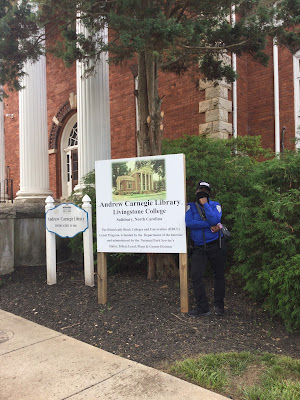I lightened my load by a pound or so when I fed a couple hundred pennies I’d collected from the road into the self-pay slot at a Walmart. I didn’t realize I’d accumulated so many, as I had just been dropping them into a bag in one of my panniers. When I discovered the heft of the bag, I knew it was time to cash it in. My collecting accelerated when I passed through Atlanta and Charlotte with more intersections and more people dispensing unwanted coins. I’d even occasionally come upon a stretch where the roadside was literally strewn with copper coins, more than I could pick up when I was at a stoplight waiting for the light to turn.
Many were so scuffed up I couldn’t pass them off on a cashier, so I had been waiting for the opportunity to anonymously unload them at a Walmart. It came as a surprise that not a single one was rejected, though many were severely battered from having been driven over and scraped repeatedly, rendering them almost unrecognizable as a penny.
The vast majority were accumulated at intersections while I was waiting for a red light to change. I collected a few others when I was on a steep climb and didn’t need to brake to stop if I spotted a coin ahead. I could simply let up on the pedals and I’d come to a halt before I passed the coin. It would be a welcome respite, allowing me a sip of water and a return to my normal heart rate. Countless others went uncollected, not meriting braking for.
I am doing a great service reintegrating these coins into circulation, as there is a considerable shortage of coins at present. Walmarts have contests among their employees offering a fifty dollar bonus to whoever brings in the “piggy bank” with the most coins. Smaller stores have had signs saying “please pay with a credit card” or “exact change only as we have no change.” That is quite a contrast to the times when stores gave discounts if one paid in cash.
I converted all the pennies into over 2,000 calories—a half gallon of chocolate milk and a mini-pecan pie. Silver coins don’t usually last long enough on the road to become scuffed, as people are more inclined to pick them up, but they still turn up.
Of the 1,796 libraries Carnegie funded in the US, 109 were on college campuses. I’ve come upon a much higher percentage of them on this journey than on any other, with fifteen of the forty-two I’ve visited so far “Academic Libraries.”
Winthrop College in Salisbury was another that was fenced in. The security guard made me go to the admissions office to get a pass to enter the campus, even though the Carnegie was less than the length of a football field away. She wouldn’t let me leave my bike with her and stroll over for a photo. When I was granted permission and entered the campus from another entrance, the guard scampered over to me when she saw me at the Carnegie. She surprisingly let me take her photo.

One of the main thoroughfares through the city is Friendly Avenue, which borders the college. The library doesn’t bare the name of Carnegie, so I wasn’t sure if it was the building he had funded, until I noticed it contained a Carnegie Room. When a 60-year old couple strolled by they confirmed it was the Carnegie Library. They had been students there forty years ago and were visiting from Virginia. They had spent many hours in the library.

The wife said I shared something in common with her husband. He had ridden his bike across the country six years ago from Virginia to San Diego. She had accompanied him as a sag wagon, visiting various places as he biked. He’d never been on a bike tour before nor since, just like my friend Jim in Atlanta after his bike trip to Guatemala when he was 22. One was enough.
Greensboro had two more Carnegies both on college campuses. One was near the center of the city at the Univerity of North Carolina, Greensboro. It had been replaced as the library in 1950 and is now the Fortney Building with administrative offices.
Winston-Salem, sister city to Greensboro, twenty-five miles west of it, had a normal public Carnegie in its city center. The city long ago outgrew it, and had no room to expand it on its corner lot. It is now a church, largely hidden by the large trees out front.









1 comment:
I spent a weeks in and around Hill Hall three years ago for. A chamber music camp. UNC is quite the nice campus and the riding around the is superlative. Plus there are many many people riding bikes both for recreation and transportation. A few of them are pro riders. Rick
Post a Comment